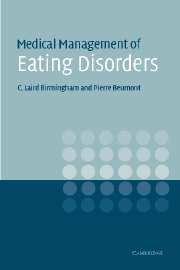Book contents
- Frontmatter
- Contents
- List of color plates
- List of contributors
- List of abbreviations
- Introduction
- PART I THE MEDICAL PERSPECTIVE
- PART II TREATMENT
- PART III SPECIAL ISSUES
- PART IV THE PSYCHIATRIC AND PSYCHOLOGICAL PERSPECTIVE
- PART V AREAS OF SPECIAL INTEREST
- 14 The role of the general practitioner
- 15 Nursing patients with anorexia nervosa
- 16 The role of the dietitian
- 17 Information for family and friends
- Bibliography
- Index
- Plate section
17 - Information for family and friends
Published online by Cambridge University Press: 18 December 2009
- Frontmatter
- Contents
- List of color plates
- List of contributors
- List of abbreviations
- Introduction
- PART I THE MEDICAL PERSPECTIVE
- PART II TREATMENT
- PART III SPECIAL ISSUES
- PART IV THE PSYCHIATRIC AND PSYCHOLOGICAL PERSPECTIVE
- PART V AREAS OF SPECIAL INTEREST
- 14 The role of the general practitioner
- 15 Nursing patients with anorexia nervosa
- 16 The role of the dietitian
- 17 Information for family and friends
- Bibliography
- Index
- Plate section
Summary
AN is a disease, like asthma is a disease. It is not dieting, a strong wish to be thin, or malingering. People afflicted with AN have within their minds two realities. One reality is a normal and healthy one. Just like you and I, those who suffer from AN want to be happy, healthy, and normal. The other reality is best understood as a phobia, a state of immense fear and concern. In AN, the phobia is that of loss of control, leading to obesity. Just like a phobia of going outside, AN has far-reaching implications. The phobia of personal obesity leads to changes in exercise, eating, unusual behaviors, and AN almost constant state of fear, anxiety, and inability to cope with life. The weight loss that results from this phobic state can be life-threatening.
What causes anorexia nervosa?
Anorexia is a disease that occurs in about one in 100–200 women and about two in 1000 men. The onset of AN is preceded by weight loss. The weight loss may have occurred for any reason, e.g. dieting, travel, diarrhea, or after surgery. AN also requires a certain genetic make-up. AN cannot occur in those who do not have a genetic predisposition to the disease. Even with a genetic predisposition and weight loss, other factors, such as social, environmental, family, or psychological stressors, may be necessary for the disease to manifest itself.
- Type
- Chapter
- Information
- Medical Management of Eating DisordersA Practical Handbook for Healthcare Professionals, pp. 257 - 259Publisher: Cambridge University PressPrint publication year: 2004



